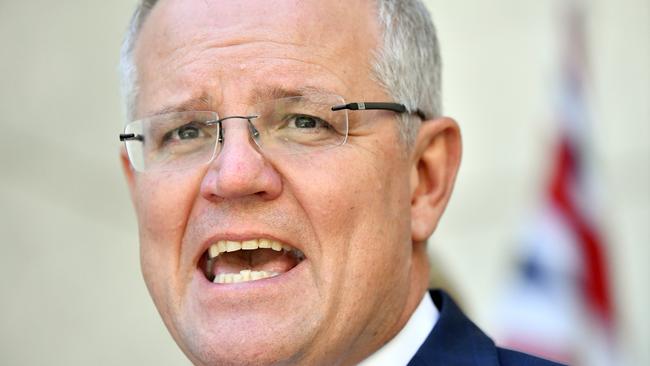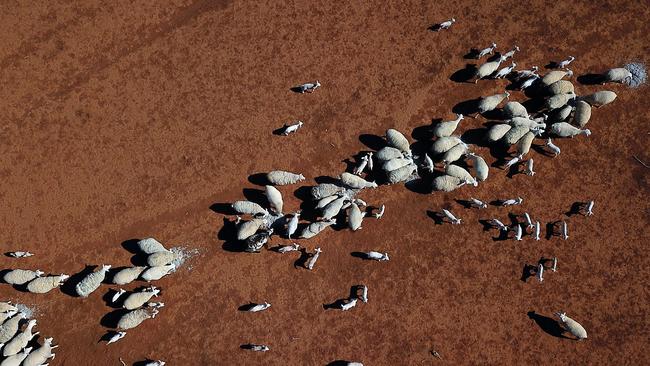Drought assistance: PM sends 100GL of help down the river
Discounted water will be released along the Murray River to ensure survival of farmers’ breeding stock.

Scott Morrison has sought to ensure the survival of farmers’ breeding stock by releasing 100 gigalitres of water along the Murray River at a discounted price to grow fodder and pasture, under a landmark drought deal that has appeased some farmers and regional Coalition MPs.
Up to 6000 farmers across South Australia, NSW and Victoria are expected to buy the water for as little as 10 per cent of the market price to produce up to 120,000 tonnes of feed for animals.
READ MORE: $1bn for business and farms to beat drought | Drought co-ordinator sacked | Dubbo cops a spray in water war | Drip-feeding our farmers during the drought
Under the plan, unveiled with a suite of measures worth about $2bn following increased pressure over the government’s response to the drought, 100GL of Murray River water held in storage upstream will be offered to farmers in the southern basin.

In return, the federal government will give South Australia $10m in drought resilience funding and replace the water taken out of the Murray by firing up the state’s desalination plant, which is expected to produce 100GL in the next 20 months at a cost of $88.4m.
The Prime Minister said many of the farmers along the Murray had seen water “going by their properties”. “This will put them to work, to help those farmers help other farmers when it comes to growing the fodder that our drought-affected farmers are going to need,” Mr Morrison said.
“This is a practical measure which both deals with the hardship along the Murray but, importantly, deals with making available more fodder, putting more into the system, so there’s more available to those breeding stock which desperately need it.”
Liberal MP Tony Pasin, who chairs the Coalition’s backbench agriculture committee and whose South Australian electorate of Barker is home to beef and dairy cattle, declared it a “smart way” of keeping the breeding herd alive. “(Mr Morrison’s) found a way to deliver revenue to some of the worst affected farmers by allowing them to produce fodder crops. It’s been well received,” he said.

The National Farmers Federation said the commitment to feed livestock through potentially enduring drought conditions was sound and called for more detail on how the water would be managed and allocated.
While the government is still finalising the water arrangements, it is expected the 4000 to 6000 farmers likely to be eligible could be able to buy as much as 25 megalitres of water each. The market price for water is between $700 and $1000 per megalitre, meaning they could buy the water for $100 a megalitre or less.
In another new drought funding announcement, schools facing financial hardship will be given $10m to go towards paying for student fees, offering textbooks and uniforms, and even providing counselling, while childcare centres will receive $5m.
The drought package also included $1bn for concessional loans for small businesses dependent on agriculture and farmers, the first two years of which will be interest-free, $138.9m in additional roads-to-recovery funding for local councils and a redirection of $200m to support new projects in drought-affected communities.
Former Nationals leader Barnaby Joyce said the package recognised that drought did not just affect farms but people in towns. He declared there was real merit in releasing the water for fodder.
“It acknowledges there’s now a critical economic need that is greater than the critical environmental need,” Mr Joyce said.
“If there’s a triple bottom line between social, economic and environmental factors, then how does that justify flooding the forest and starving the people?”
South Australian Greens senator Sarah Hanson-Young accused the government of cutting the state’s river water allocation and said she was worried there would be less water downstream and higher water prices in Adelaide.
Mr Morrison said there was a “net zero impact” on South Australia because the water being offered to farmers was being replaced and the cost of producing additional water out of its desal plant would be met by the federal government.
If in the unlikely scenario South Australia decides that the desal plant cannot produce the full 100GL quota, the government will consider as a contingency taking water out of the Snowy Hydro scheme to offer farmers.




To join the conversation, please log in. Don't have an account? Register
Join the conversation, you are commenting as Logout